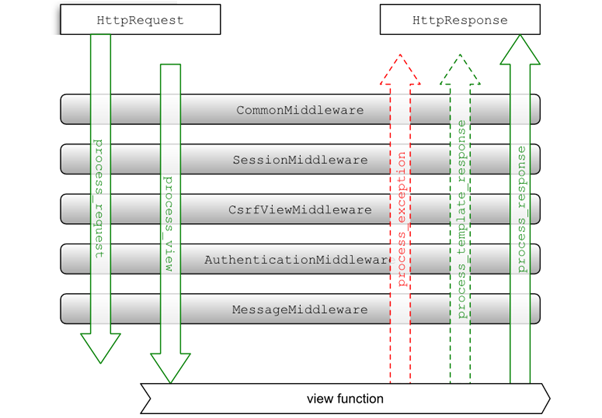Hey, there fellow Djangomers and Pythonistas,
At ScaleReal we work extensively on Python/Django Applications and have built a lot of highly scalable applications for various clients of ours.
While working on such apps it’s very important to understand the ins and outs of Django’s middleware workings.
So, In this article, we’ll learn about Middleware in Django, why to use them, how it works & how to create custom middleware in Django. So, let’s dive in!
Here’s a list of everything which will be covered in this article:
What is Middleware in Django?
How does Middleware work?
What are the types of Middleware?
How to write a custom Middleware in Django?
Things to remember when using middleware
1. What is Middleware in Django?
In Layman terms 👨💼, a Middleware is something which acts as a bridge between two parts of a program or the system that enables communication between them. In technical terms 👨💻, Middleware is a framework of hooks into Django’s request/response processing. It’s a light, low-level “plugin” system for globally altering Django’s input or output. Each middleware component is responsible for doing some specific function.
2. How does Middleware work? 🤔
When a user makes a request from your application, a WSGI handler is instantiated, which handles the following things:
- Imports project’s
settings.pyfile and Django exception classes. - Loads all the middleware classes which are written in
MIDDLEWAREtuple located insettings.pyfile - Builds list of methods which handle processing of request, view, response & exception.
- Loops through the request methods in order.
- Resolves the requested URL
- Loops through each of the view processing methods
- Calls the view function
- Processes exception methods (if any)
- Loops through each of the response methods in the reverse order from request middleware.
- Builds a return value and makes a call to the callback function.
 Working of Middleware ⬇⬆
Working of Middleware ⬇⬆
3. What are the types of Middleware?
There are two types of Middleware in Django:
- Built-in Middleware
- Custom Middleware
Built-in Middleware are provided by default in Django when you create your project. You can check the default Middleware in settings.py file of your project.
| MIDDLEWARE = [ | |
| 'django.middleware.security.SecurityMiddleware', | |
| 'django.contrib.sessions.middleware.SessionMiddleware', | |
| 'django.middleware.common.CommonMiddleware', | |
| 'django.middleware.csrf.CsrfViewMiddleware', | |
| 'django.contrib.auth.middleware.AuthenticationMiddleware', | |
| 'django.contrib.messages.middleware.MessageMiddleware', | |
| 'django.middleware.clickjacking.XFrameOptionsMiddleware', | |
| ] |
Custom Middleware — You can write your own middleware which can be used throughout your project. Let’s see how we can do that!
4. How to write a custom Middleware in Django? ✍
- Create a python package (a folder with
__init__.pyinside) named asmiddleware - Create a file named
custom_middleware.py(or anything which you like) and a regular Python function / class in it. - You can write middleware as a function or as a class whose instances are callable.
Function based Middleware:
| def simple_middleware(get_response): | |
| # One-time configuration and initialization. | |
| def middleware(request): | |
| # Code to be executed for each request before | |
| # the view (and later middleware) are called. | |
| response = get_response(request) | |
| # Code to be executed for each request/response after | |
| # the view is called. | |
| return response | |
| return middleware |
Class based Middleware:
| class ExampleMiddleware: | |
| def _init_(self, get_response): | |
| self.get_response = get_response | |
| def _call_(self, request): | |
| # Code that is executed in each request before the view is called | |
| response = self.get_response(request) | |
| # Code that is executed in each request after the view is called | |
| return response | |
| def process_view(request, view_func, view_args, view_kwargs): | |
| # This code is executed just before the view is called | |
| def process_exception(request, exception): | |
| # This code is executed if an exception is raised | |
| def process_template_response(request, response): | |
| # This code is executed if the response contains a render() method | |
| return response |
Now the final step will be to add your custom middleware in MIDDLEWARE List in settings.py file
| MIDDLEWARE = [ | |
| … | |
| 'your_app.middleware_directory.custom_middleware_file.CustomMiddleware_class', | |
| ] |
All set ✔ Now you can use your custom middleware easily 😁
Further, let’s understand the special methods of class-based middleware:
- process_request: The request object will be created while Django goes through process_request method in each middleware. After that, it resolves which view to be called soon after the request object is created with the help of
ROOT_URLCONFkey in settings file. - process_view(request, view_func, view_args, view_kwargs):
requestis the HttpRequest object andview_funcis the function that is being called. It will be called just before calling the view. - process_response: The response will be the final output Django will process after executing the
process_responsemethod in each middleware which will be HttpResponse object. - process_template_response(request, response):
requestis an HttpRequest object.responseis the TemplateResponse object (or equivalent) returned by a Django view or by a middleware. - process_exception(request, exception):
requestis an HttpRequest object.exceptionis an Exception object raised by the view function. This method is called when the view raises an exception.
5. Things to remember when using middleware:
- Order of middleware is important.
- A middleware only need to extend from class object.
- A middleware is free to implement some of the methods and not implement other methods.
- A middleware may implement
process_requestbut may not implementprocess_responseandprocess_view.
That’s it from my side devs! 👨💻
Thanks for reading! If you enjoyed reading this article, please click the 👏 button and share to help others find it! Feel free to leave a comment 💬 below. You can connect with me on GitHub, LinkedIn, Twitter.
Have feedback? Let’s connect here.
~Akash Shrivastava
